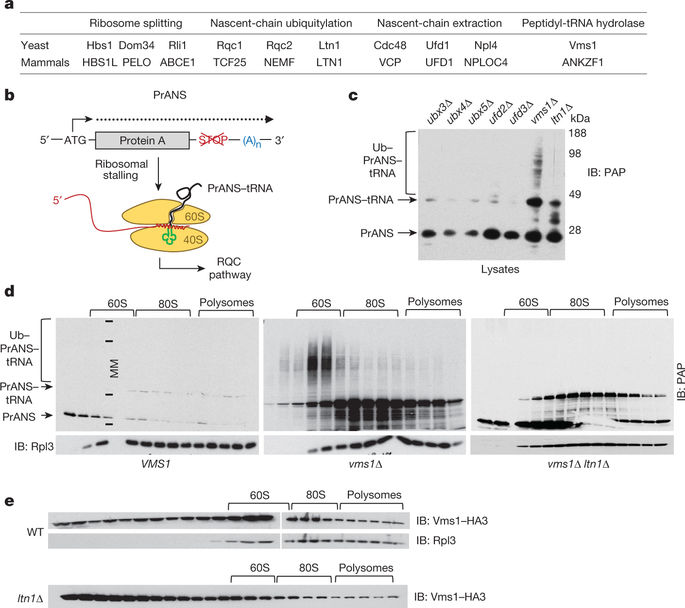Vms1 and ANKZF1 peptidyl-tRNA hydrolases release nascent chains from stalled ribosomes
Rati Verma, Kurt M. Reichermeier, A. Maxwell Burroughs, Robert S. Oania, Justin M. Reitsma, L. Aravind, Raymond J. Deshaies
Index: 10.1038/s41586-018-0022-5
Full Text: HTML
Abstract

Ribosomal surveillance pathways scan for ribosomes that are transiently paused or terminally stalled owing to structural elements in mRNAs or nascent chain sequences1, 2. Some stalls in budding yeast are sensed by the GTPase Hbs1, which loads Dom34, a catalytically inactive member of the archaeo-eukaryotic release factor 1 superfamily. Hbs1–Dom34 and the ATPase Rli1 dissociate stalled ribosomes into 40S and 60S subunits. However, the 60S subunits retain the peptidyl-tRNA nascent chains, which recruit the ribosome quality control complex that consists of Rqc1–Rqc2–Ltn1–Cdc48–Ufd1–Npl4. Nascent chains ubiquitylated by the E3 ubiquitin ligase Ltn1 are extracted from the 60S subunit by the ATPase Cdc48–Ufd1–Npl4 and presented to the 26S proteasome for degradation3,4,5,6,7,8,9. Failure to degrade the nascent chains leads to protein aggregation and proteotoxic stress in yeast and neurodegeneration in mice10,11,12,13,14. Despite intensive investigations on the ribosome quality control pathway, it is not known how the tRNA is hydrolysed from the ubiquitylated nascent chain before its degradation. Here we show that the Cdc48 adaptor Vms1 is a peptidyl-tRNA hydrolase. Similar to classical eukaryotic release factor 1, Vms1 activity is dependent on a conserved catalytic glutamine. Evolutionary analysis indicates that yeast Vms1 is the founding member of a clade of eukaryotic release factor 1 homologues that we designate the Vms1-like release factor 1 clade.
|
Fatal swine acute diarrhoea syndrome caused by an HKU2-relat...
2018-04-04 [10.1038/s41586-018-0010-9] |
|
Crystal structures of the gastric proton pump
2018-04-04 [10.1038/s41586-018-0003-8] |
|
The evolutionary history of vertebrate RNA viruses
2018-04-04 [10.1038/s41586-018-0012-7] |
|
Accelerated increase in plant species richness on mountain s...
2018-04-04 [10.1038/s41586-018-0005-6] |
|
Characterization of the 1S–2S transition in antihydrogen
2018-04-04 [10.1038/s41586-018-0017-2] |